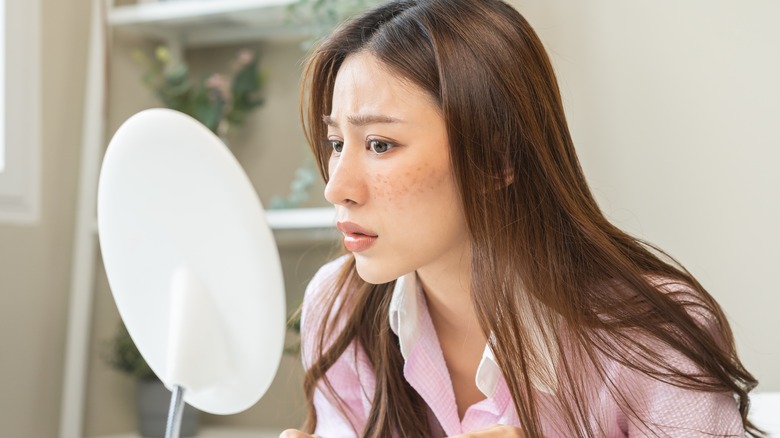Could Your Birth Control Be Causing Melasma?
From preventing pregnancies to lessening the symptoms of pre-menstrual syndrome, clearing up acne, and dealing with unwanted hair growth around the midline of our body, birth control methods (including the pill) can sometimes be a woman's best friend. A 2022 women's health survey by the Kaiser Family Foundation shows that 90% of women surveyed (aged 18 to 64) have used oral contraception at some point in their lives.
According to Reproductive Facts, hormonal contraception methods reduce the risk of uterine, ovarian, and colon cancers. They also help with endometriosis symptoms (a condition in which the tissue lining the uterus grows outside of it, resulting in painful menstrual cramps and heavy blood flow). Moreover, if you have experienced ovarian cysts in the past, birth control can prevent such cysts from forming again (via WebMD).
The benefits of birth control are undeniable and stretch beyond their obvious contraceptive purpose. The Guttmacher Institute indicates that 14% of birth control users in the United States rely on them to help with other non-contraceptive purposes. However, what happens when you start using the pill and dark spots appear on your skin? Could your birth control be causing your melasma, and is that a deal breaker between you and the pill?
What is melasma?
Melasma –- from the Greek word "melas" for black –- is a common skin condition manifested as dark brown or bluish-gray spots on the skin. This type of hyperpigmentation typically appears on the cheeks, upper lip, forehead, and parts of our arms and neck that are exposed to frequent UV radiation. According to the Journal of the American Academy of Dermatology, more than 5 million Americans are affected by it, and, while common, it's not something that should be a source of concern.
What's more board-certified dermatologist Dr. Corey L. Hartman, who is also the founder and medical director of Skin Wellness Dermatology, tells Byrdie that melasma "appears as lacy, reticulated brown patches on sun-exposed skin." While all dark spots are hyperpigmentation, not all hyperpigmentation is melasma. Instead, melasma is a distinct category that falls under the greater umbrella of hyperpigmentation and is classified based on its causes (via Healthline). But what are the exact causes of melasma?
What causes melasma?
Melasma, as a form of hyperpigmentation, is caused by the release of excess pigment on our skin, resulting in discoloration and dark patches. At the basal level of our skin are the melanocytes — the pigment-producing cells. While these cells are genetically predisposed to emit a certain amount of pigment on our skin, sometimes extraneous factors trigger them to work extra hard and release more melanin than usual. This over-production results in melasma spots. While melasma can affect both men and women, the prevalence amongst women is significantly higher (9 out of 10, per research in the Journal of Clinical and Aesthetic Dermatology). Although debilitating to one's self-esteem, melasma is actually harmless.
Several different factors contribute to the appearance of melasma. Genetics play a role and can explain why some people are more prone to having melasma than others (via Kirsch Dermatology). Moreover, darker-skinned individuals are typically more susceptible to developing melasma than those with fairer skin.
Dubbed the "pregnancy mask," melasma is observed on 15% to 50% of pregnant women's faces, according to the Cleveland Clinic, and there is a clear consensus on the culprit behind this phenomenon: hormones. During pregnancy, a woman's higher estrogen levels can affect their skin health. These hormones trigger the melanocytes to create more pigment than normal, hence leading to hyperpigmentation or melasma. Since several birth control methods directly impact a woman's hormone levels, they're considered to be among the leading melasma causes.
Birth control and melasma
There are several types of birth control available, and they fall under one of two categories: hormonal and non-hormonal. Non-hormonal methods include the male and female condom, cervical cap, diaphragm, spermicides, and sponge (via the United Kingdom's NHS). On the other hand, hormonal birth control methods include lab-made progesterone and estrogen. These methods include oral contraceptives, skin patches, injectable progestin, vaginal rings, injectible progestin, intrauterine progesterone contraception, and implantable progestin under the skin (via UpToDate).
While females naturally produce both progesterone and estrogen, when used in birth control methods, they work to prevent pregnancy. This is achieved in several ways. Firstly, hormonal birth control prevents ovulation. Secondly, it makes the lining of the uterus thinner, meaning that should an egg be fertilized, it won't be able to attach itself in the womb. Finally, progesterone and estrogen thicken the mucus around the cervix so that the sperm cannot enter the womb and fertilize the egg.
However, since hormones primarily induce melasma, an increase in these hormones, albeit lab generated, will inadvertently trigger a reaction in our melanocytes, leading to excess melanin production and melasma's appearance. As Dr. Hadley King, a board-certified dermatologist specializing in cosmetic and surgical dermatology, tells Byrdie, it doesn't matter which type of birth control you use; if it contains hormones, it could possibly lead to melasma.
Will the interruption of birth control treat melasma?
If hormonal birth control leads to melasma, will interrupting the said methods treat hyperpigmentation and restore your skin to its former natural tan and evened color? According to the Cleveland Clinic, if the primary cause of melasma is the birth control a woman uses, then interrupting it will improve the skin's discoloration and brighten the dark patches. However, it typically takes four or five months for noticeable results to show.
Nevertheless, if your dark patches are the result of a combination of causes such as hormones, sun exposure, and genetics, chances are that melasma will improve but will not completely go away. The dermatologist and director of cosmetic and clinical research in dermatology at the Mount Sinai Hospital in New York City Dr. Joshua Zeichner, M.D., tells Byrdie that the cause of melasma may be actually quite difficult to identify.
Unfortunately, because of the combination of factors leading to it, and the inability to exactly pinpoint the cause, treatment is tricky. In fact, unlike other types of hyperpigmentation, melasma is notoriously difficult to treat. Dr. Hadley King explains that while melasma can improve, it cannot be cured and is unlikely to go away completely (via Byrdie).
Treating melasma
Columbia Skin Clinic explains that since hormones are a "personalized set of chemicals," each person will react differently to treatment, with success rates varying from one woman to the next. Fortunately, several treatment options are available for women whose melasma stubbornly persists despite putting a halt to hormonal birth control methods.
Harvard Health Publishing suggests the use of topical creams with tyrosinase inhibitors to prevent the excess production of melanin and the formation of new pigments. Such inhibitors are found in creams with agents like glycolic acid, vitamin C, retinol, azelaic acid, kojic acid, niacinamide, and cysteamine acid. Moreover, hydroquinone is a very potent ingredient in combating melasma, even though it has been brought under severe scrutiny due to its potential side effects (via WebMD). Finally, one could also turn to more radical treatments, including chemical peels and light-based procedures.
Treatment efficacy will also depend on whether you take the right steps to prevent your melasma from worsening. Direct exposure to the sun, use of tanning beds, radiation from LED screens, certain aromatic soaps, and even skincare products containing allergens will exacerbate melasma and seriously hamper any treatment efforts. Consequently, any treatment should be paired with the use of sunscreen lotions has at least an SPF of 30.
Alternative birth control methods to consider
If you would like to avoid the symptoms of melasma caused by hormonal birth control but you are not too keen on the idea of male or female condoms — and cervical caps and diaphragms are making you uncomfortable — there are two other options you can consider (via Healthline). The mini-pill is an excellent choice if you like the ease (and the perks!) of the pill but want a substitute that does not have hormonal side effects. Contrary to traditional hormonal birth control pills, the mini-pill is a progestin-only pill. Since progestin is a byproduct of progesterone, it is less likely to trigger a reaction in your melanocytes, leading to excess melanin and hyperpigmentation of your skin.
While IUDs (intra-uterine devices) have their own varying level of hormones, they are generally considered to have lower hormonal dosages than oral contraceptives. Moreover, switching to IUDs can help with your melasma outbreak since they do not contain estrogen. Currently, there is also the option to avoid hormones altogether by choosing a non-hormonal IUD available in the United States. ParaGard, also known as the copper IUD, does not contain any hormones but does come with its own set of side effects, such as heavier bleeding. Even though melasma can be frustrating, it can improve with proper treatment, much like any other skin condition. If you are considering switching your birth control to combat your melasma outbreak, speak with your gynecologist first to find the best option for your needs.






